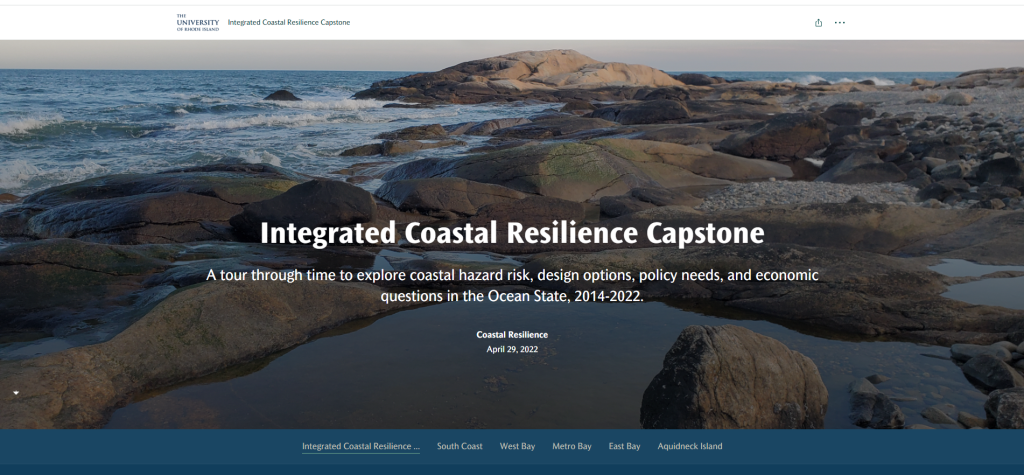By Todd McLeish

Illustration by URI landscape architecture student Monica Rao of a proposed boardwalk at the Bucklin Point wastewater treatment facility in East Providence
Rising sea levels and extreme storms due to climate change are predicted to flood coastal communities and businesses, and cut off vital emergency access in the coming years.
Emi Uchida, a URI professor of environmental economics, calls these issues “wicked problems that are so complex that we don’t have optimal solutions right away.” That makes them perfect for tackling by students in the University of Rhode Island’s unique “capstone” experience in coastal community resilience, which gives undergraduates from different disciplines an opportunity to work on a common challenge over the course of one to two semesters. Uchida, who is one of several professors involved, says the experience provides students “so many different angles to look at [these issues] from. It’s been a very fruitful collaboration.”
Rather than learning new material, students take what they have learned in all of their other classes and apply it to a particular issue, such as flooding in Westerly’s Watch Hill business district or sea level rise and storm threats to wastewater treatment facilities in Providence and East Providence. Students majoring in URI’s Landscape Architecture, Marine Affairs, Natural Resource Economics, and Civil and Ocean Engineering utilize their unique knowledge and skill sets to work together to develop designs and recommendations that are provided to community officials and planners.
This unique collaboration selects a community each year to focus on projects related to coastal resilience and climate adaptation. The program is sponsored by Rhode Island Sea Grant and has been highlighted by the National Oceanic and Atmospheric Administration (NOAA) as a model for the rest of the country.
“It started several years ago as a way to expose the landscape architecture students to coastal issues, sea level rise maps, and how historic properties in Wickford would be affected,” says Teresa Crean, formerly of Rhode Island Sea Grant and the URI Coastal Resources Center, now the Barrington town planner, who serves as the liaison between the classes and the stakeholder groups. “The idea was that the students could include these types of projects in their portfolios and use them in interviews to pursue landscape architecture jobs with an environmental focus. And it evolved from there.”
Not only do the students meet with stakeholders and tour their assigned communities, but they discuss the issues among their fellow students in the other classes and share their research, just like they would in a real-world professional setting.
The collaboration with stakeholders and with students from other disciplines was one of the most important learning moments for former environmental economics student Alex Esterly, whose capstone class looked at vulnerable areas in Watch Hill, where flooding of Bay Road affects its retail shops and cuts off access to the beach at Napatree Point.
“It was interesting to see how our different fields came together to address these massive projects using each other’s information and help,” he says. “It was everyone working on separate parts of a single project, and in the end we all came together.”

Monica Rao, URI landscape architecture student
Esterly’s focus during the class was on identifying financing strategies for coastal resilience projects. He and his classmates identified a half dozen possible financing opportunities that have been used by coastal communities to pay for projects designed to make their regions more resilient to climate change, but the students concluded that one of them was preferred – resilience bonds. Unlike high-risk catastrophe bonds, in which investors bet on whether or not communities will be struck by a major catastrophe like a flood or hurricane, resilience bonds enable communities to finance resilience projects that will lower the likelihood of damage when the inevitable catastrophe strikes.
“It’s a safer investment all around because it’s less likely the investors will lose their money and the town still gets the money to finance their resilience projects,” Esterly says.
Monica Rao was one of the landscape architecture students in the class that looked at the wastewater treatment facilities in Providence and East Providence. She decided to focus her ideas on a strategy for managing the excess stormwater that runs off one of the sites during storms. She was inspired by a project in China called Academy in the Park, where runoff was collected from impermeable surfaces and filtered through constructed wetlands and floating islands so it can be reused.
“I designed three depressions in the landscape that would imitate the wastewater plant in a more naturalistic form,” she says. The first depression separates gray water from compostable solids. The runoff then enters the second depression that includes plants that help with filtration and improve water quality. The clean water then enters the final depression populated with low-maintenance plants that create wildlife habitat. A boardwalk around the site provides opportunities for tours and educational programs.

Monica Rao’s proposed solution for managing stormwater runoff using constructed wetlands at Bucklin Point.
“We really had the freedom to be creative,” says Rao, who is now pursuing a master’s degree at URI in environmental science and management while working for the Coastal Resources Center. “The other students had some amazing ideas. One created seven lanes of plants, each one telling a story. Another created islands on the water. We all came up with creative designs and solutions that wouldn’t degrade the landscape.”
Although the recommendations made by the students aren’t intended to be directly implemented by the stakeholders, they often lead to additional discussions and outside-the-box thinking that enable communities to see more clearly the options before them and spur them to take necessary action.
Jocelyn Lahey, the executive director of the Watch Hill Conservancy, was impressed with the diversity of innovative solutions the students proposed for the Watch Hill district. The environmental economics students, she says, made it clear that taking no action was completely impractical if the village expected to persist. And the engineers and landscape architects helped the stakeholders envision the future of the area.
“It was a great experience working with and hearing from the students,” Lahey says. “We may not take any individual student’s idea and implement it, but what the students did was provide us with such a variety of possibilities that we hadn’t considered that we will absolutely reflect on in the coming months.”
This story map highlights projects that have been undertaken by the University of Rhode Island undergraduate senior Integrated Coastal Resilience Capstone from 2014-2022.

